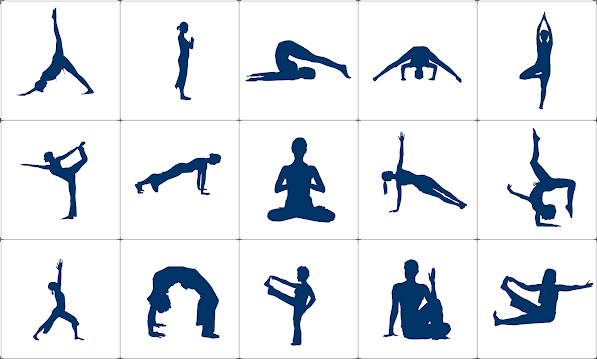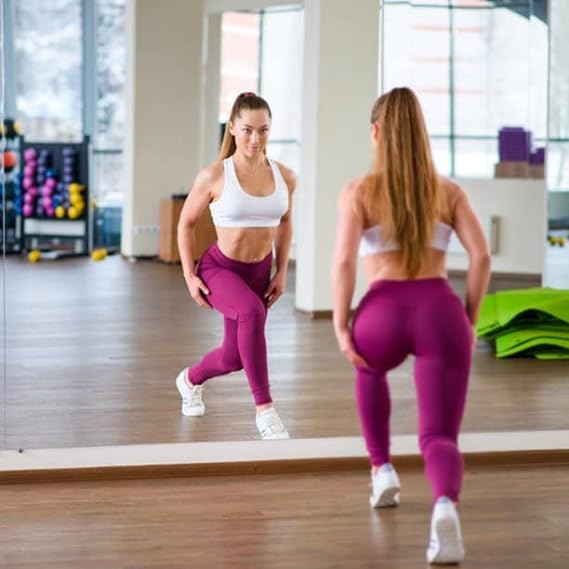Bodyweight
exercises are a fantastic way to build strength, improve flexibility, and
enhance overall fitness without the need for equipment. However, selecting the
right exercises is crucial to ensure a safe and effective workout routine. In
this article, we'll explore how to choose appropriate bodyweight exercises
based on your fitness level, goals, and physical condition.
There are 3
Simple Steps You Can Follow to choose appropriate bodyweight exercises,
1. Research on exercises suitable for your
fitness level and goals
Researching
and choosing exercises suitable for your fitness level and goals is a critical
step in creating an effective workout routine. By assessing your fitness level,
understanding your goals, researching exercises, considering variety,
evaluating safety, and listening to your body, you can create a workout routine
that helps you achieve your fitness goals safely and effectively.
The
Fitness Level Factor
- The Glorious Beginner:Just starting your fitness journey?, Focus on mastering proper form over intensity. Bodyweight exercises like squats, lunges, wall pushes (push-ups against a wall), planks, and rows are fantastic choices. These exercises build a strong foundation and establish healthy movement patterns.
- The Confident Intermediate:
You've conquered the basics, and it's time to spice things up! Variations like single-leg squats, jumping lunges, incline push-ups, side planks, and inverted rows will challenge your strength, coordination, and push you to the next level. - The Badass Advanced:
Ready to take your fitness to new heights? Pistol squats, muscle-ups, handstand push-ups, full planks with leg raises, and one-arm rows will elevate your training. Remember, prioritize proper form for safety and effectiveness.
Goal Setting - Your Fitness Roadmap
- Building a Muscle Fort: Craving sculpted muscles? Focus
on compound exercises that work multiple muscle groups at once. Squats,
lunges, push-ups, dips, and rows are your best bets. To progressively
overload (gradually increase difficulty), perform more repetitions, sets,
or hold exercises for longer durations.
- Turning Up the Calorie Furnace: Shedding weight requires a
different approach. Design high-intensity circuits that combine bodyweight
exercises with short rest periods to get your heart rate soaring. Jumping
jacks, burpees, mountain climbers, and squat jumps are your
calorie-burning champions.
- Unlocking Mobility and Flexibility: Bodyweight exercises are a gift for improving your mobility and flexibility. Include lunges with torso twists, arm circles, inchworms, and dedicated stretches in your routine to achieve a well-rounded workout.
Research
Like a Pro - Become a Fitness Guru
Now that you
understand your fitness level and goals, it's time to leverage the power of
research! Here are some tips for becoming a bodyweight exercise guru:
- Government Websites: Government health resources
like the https://www.nia.nih.gov/)
offer reliable information on exercises suitable for different fitness
levels and goals.
- Reputable Fitness Websites: Explore websites run by
certified personal trainers or reputable fitness organizations. Look for
clear instructions, modifications for different levels, and exercise
variations. here are some examples:
- Fitness Apps and YouTube
Channels: Many
fitness apps and YouTube channels offer free bodyweight exercise
tutorials. Look for channels with certified instructors who prioritize
proper form and cater to different fitness levels.
2. Understand
the correct form and technique for each exercise
Proper form and technique are essential components of a successful workout routine. Whether you're a beginner or a seasoned fitness enthusiast, understanding the correct form for each exercise can help you maximize results while minimizing the risk of injury.
Why Correct
Form Matters: Performing exercises with proper form ensures that you're
targeting the intended muscles effectively. It also helps prevent strain on
joints and ligaments, reducing the risk of injury. Additionally, using correct
form can lead to better performance and results over time, as you're engaging
the right muscles in the right way.
How to Learn
Correct Form:
1.
Educate Yourself: Start by researching proper form for different exercises. There are
plenty of resources available online, including videos, articles, and
tutorials, that can help you understand the correct technique.
2.
Seek Professional Guidance: If you're unsure about how to perform a particular exercise,
consider working with a certified personal trainer. They can provide one-on-one
instruction and correct your form in real-time.
3.
Start Slow:
When learning a new exercise, start with lighter weights or resistance bands to
focus on form. Gradually increase the intensity as you become more comfortable
with the movement.
4. Use Mirrors:
Position yourself in front of a mirror to check your form while performing exercises. This can help you spot any errors and make adjustments as needed.
5. Listen to Your Body: Pay attention to how your body feels during each exercise. If something feels uncomfortable or painful, stop immediately and reassess your form.
Tips for Maintaining Correct Form:
1.
Engage Your Core: Keep your core muscles engaged throughout the exercise to stabilize your
spine and protect your lower back.
2.
Focus on Range of Motion: Perform each exercise through its full range of motion to
ensure that you're engaging the muscles fully.
3.
Control the Movement: Avoid using momentum to perform an exercise. Instead, focus on
controlled movements to target the muscles effectively.
4.
Mind Your Posture: Maintain proper posture throughout the exercise, including a straight
back and neutral spine.
5.
Breathe Properly: Remember to breathe steadily and rhythmically throughout each exercise.
Exhale during the exertion phase and inhale during the relaxation phase.
Understanding
the correct form and technique for each exercise is crucial for a safe and
effective workout routine. By educating yourself, seeking professional
guidance, starting slow, using mirrors, and listening to your body, you can
master the proper form for every exercise and maximize your fitness results.
Remember, quality over quantity is key, so prioritize form and technique in
your workouts for optimal results.
3. Create
an exercise sequence for your workout
A
well-structured workout sequence is essential for maximizing the effectiveness
of your fitness routine. Whether your goal is to build muscle, improve
cardiovascular health, or enhance flexibility, a thoughtful combination of proper warm-up, main workout, and cool-down exercises can help you achieve your goals
safely and efficiently. Now, we'll explore how to create an exercise sequence
that will optimize your workout and minimize the risk of injury.
Warm-Up Exercises:
The warm-up is a crucial part of any workout as it prepares your body for the physical exertion ahead. It helps increase blood flow to your muscles, improve flexibility, and reduce the risk of injury. Here are some warm-up exercises you can include in your routine:
1.
Joint Rotations: Start with gentle joint rotations for your neck, shoulders, arms,
wrists, hips, knees, and ankles to loosen up your joints and improve mobility.
2.
Dynamic Stretches: Perform dynamic stretches such as leg swings, arm circles, and torso
twists to increase flexibility and range of motion.
3.
Cardiovascular Exercise: Incorporate light cardio, such as jogging in place, jumping
jacks, or high knees, to raise your heart rate and warm up your muscles.
Main
Workout Exercises: The main workout is where you'll
focus on your specific fitness goals, whether it's strength training,
cardiovascular exercise, or a combination of both. Here's how to structure your
main workout:
1.
Strength Training: If your goal is to build strength, start with compound exercises that
target multiple muscle groups, such as squats, lunges, push-ups, and rows.
Include a variety of exercises to target different muscle groups and prevent
muscle imbalances.
2.
Cardiovascular Exercise: If you're focusing on cardio, choose activities like
running, cycling, or swimming, and vary the intensity based on your fitness
level. Aim for at least 20-30 minutes of continuous aerobic activity.
3.
Flexibility and Balance: Don't forget to include exercises that improve flexibility
and balance, such as yoga poses or stability exercises, to round out your
workout and reduce the risk of injury.
Cool-Down
Exercises: The
cool-down is just as important as the warm-up, as it helps your body transition
from exercise to rest, prevents muscle soreness, and promotes recovery. Here
are some cool-down exercises to include:
1.
Static Stretches: Perform static stretches for major muscle groups, holding each stretch
for 15-30 seconds to improve flexibility and reduce muscle tension.
2. Foam Rolling:
Use a foam roller to massage your muscles and release tension, focusing on areas that feel tight or sore.
3.
Deep Breathing:
Finish your cool-down with deep breathing exercises to relax your body and
mind, promoting a sense of calm and well-being.
Creating a
well-rounded exercise sequence that includes warm-up, main workout, and
cool-down exercises is essential for a safe and effective workout. By
incorporating these elements into your routine, you can maximize your fitness
results, reduce the risk of injury, and enhance your overall well-being.
Remember to listen to your body, adjust the intensity as needed, and stay
consistent with your workout routine for long-term success.
As for
conclusion, selecting appropriate bodyweight exercises is a fundamental step in
crafting a workout routine that is both effective and safe. By following above
steps, you can choose exercises that challenge you without risking injury. It's
essential to start with basic exercises and gradually progress to more
challenging variations as you build strength and confidence.
Lastly,
remember that fitness is a journey, and it's important to listen to your body
and adjust your workout routine as needed. By choosing appropriate bodyweight
exercises and staying consistent with your workouts, you can achieve your
fitness goals and enjoy a healthier, stronger body.











Post a Comment